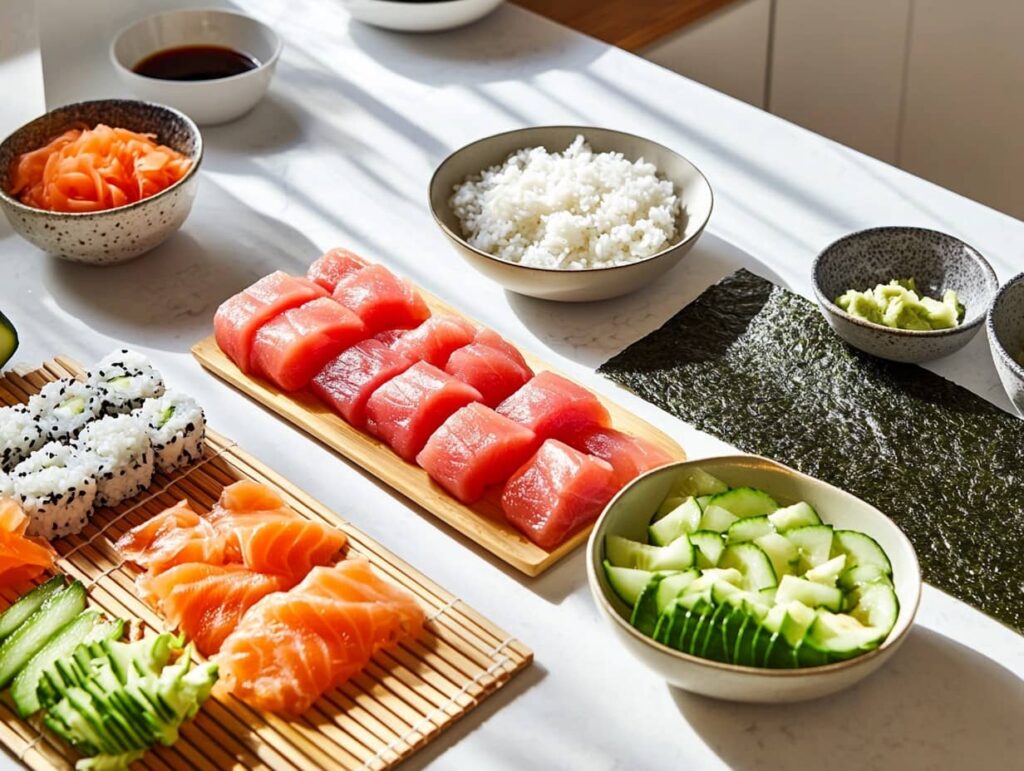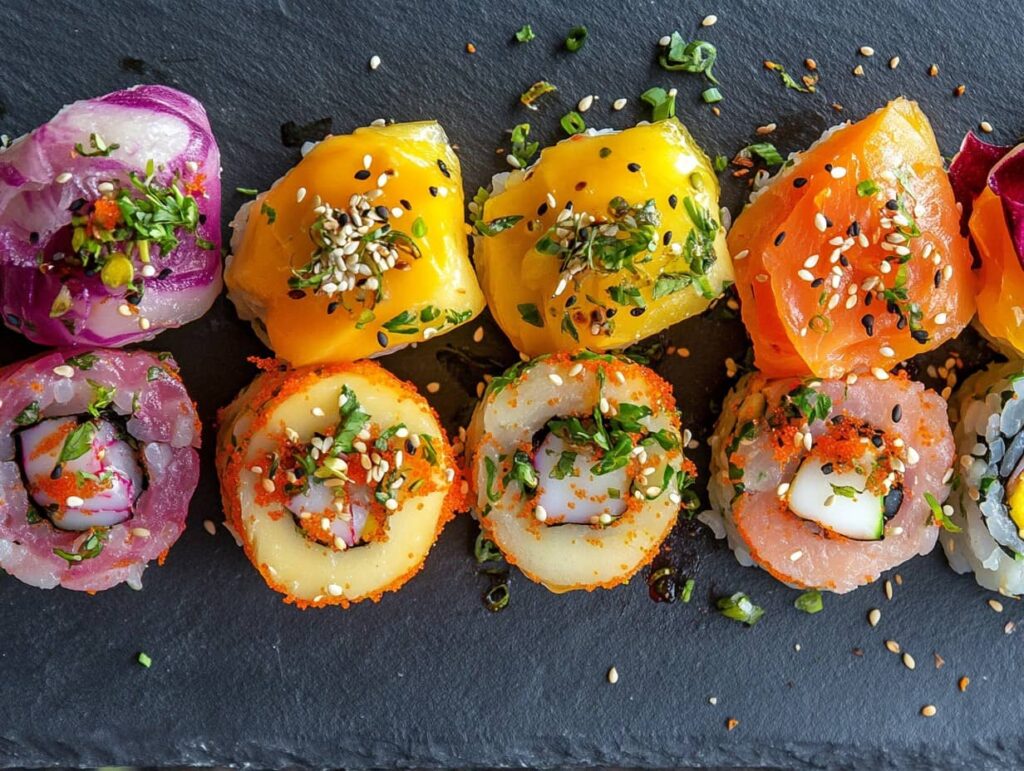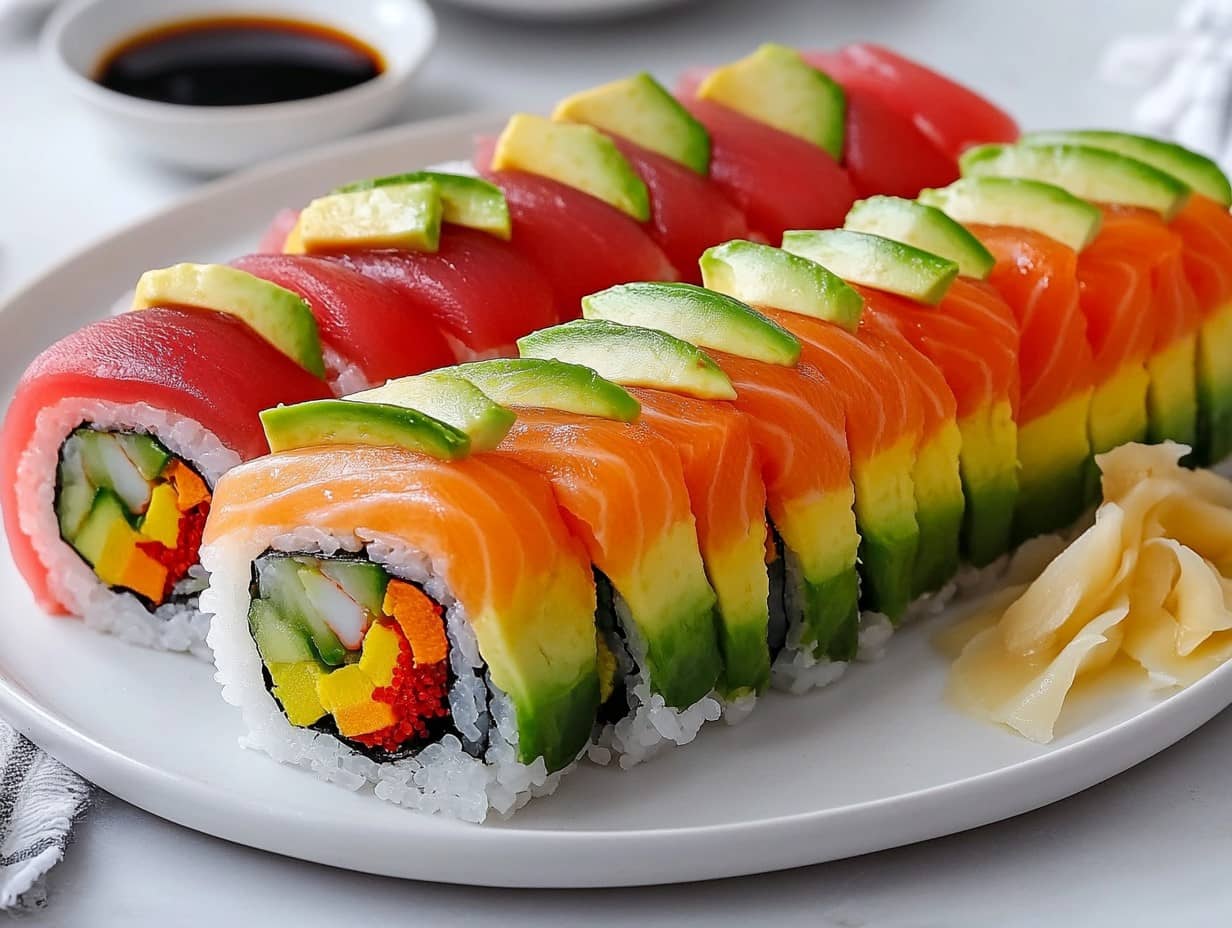If you’ve ever sat at a sushi bar and marveled at a vibrant, multicolored roll topped with fresh fish and creamy avocado, chances are you’ve spotted a rainbow roll. This iconic sushi creation is not just a feast for the eyes; it’s an explosion of flavors that can make your taste buds dance with joy. Whether you’re a sushi newbie or a seasoned enthusiast, the rainbow roll has something for everyone. Let’s dive into what makes it so special and how you can enjoy it to the fullest.
What Is a Rainbow Roll? A Delicious Sushi Masterpiece
A rainbow roll is a type of sushi roll known for its striking appearance and delightful mix of textures and flavors. It’s essentially a California roll taken to the next level, with a variety of fresh fish and avocado layered on top. The roll gets its name from the “rainbow” of colors created by the different toppings bright pink tuna, orange salmon, pale white fish, and the rich green of avocado.
But the rainbow roll isn’t just about looks. Each bite offers a harmonious blend of creamy, tangy, and savory notes, making it one of the most popular sushi rolls worldwide. For a deeper dive into the distinction between rolls, check out this comparison of rainbow roll and California roll.
Origins of the Rainbow Roll: History and Evolution
The rainbow roll emerged during the sushi boom in the United States, showcasing a modern twist that combines classic Japanese techniques with a creative presentation. Its inspiration, the California roll, served as a gateway to introducing raw fish to hesitant diners.
Did you know? The rainbow roll was inspired by the California roll another American invention. By adding fresh fish to the California roll, sushi chefs found a way to introduce raw fish to hesitant diners. The result? A gateway sushi roll that’s now beloved around the world.
Key Ingredients in a Traditional Rainbow Roll
To make a rainbow roll, you’ll need a mix of classic sushi staples and fresh, high-quality ingredients. Each component plays a role in creating the perfect balance of taste and texture.

Base Ingredients: Sushi Rice and Seaweed
The foundation of any sushi roll is the rice. Rainbow rolls use seasoned sushi rice, which is sticky, slightly sweet, and tangy thanks to a mix of vinegar, sugar, and salt. The rice is wrapped in a sheet of nori (seaweed) for structure.
Variety of Fish: Tuna, Salmon, and More
The “rainbow” effect comes from the assortment of fish used as toppings. Common choices include:
- Tuna: Adds a bold, meaty flavor.
- Salmon: Offers a buttery, rich taste.
- White fish: Brings a mild, delicate flavor to balance the stronger fish.
Learn more about the perfect toppings with this guide to rainbow roll toppings.
Toppings: Avocado, Cucumber, and Other Essentials
The creamy texture of avocado and the crunch of cucumber are key to the roll’s appeal. Together, they add freshness and contrast to the rich fish and rice. Some chefs even get creative by adding other toppings like mango or spicy mayo for a unique twist.
Pro Tip: Always use the freshest fish and ingredients you can find. The quality of your ingredients will make or break your rainbow roll! 🐟
How to Make a Rainbow Roll at Home
Making a rainbow roll involves crafting a California roll base, then layering it with fresh fish and avocado slices. For a detailed step-by-step guide, visit How to Make Rainbow Rolls at Home.
Tools and Equipment Needed for Perfect Sushi Rolls
Before you get started, gather your tools. Here’s what you’ll need:
- Bamboo sushi mat: Essential for rolling sushi.
- Sharp knife: For clean, precise cuts.
- Rice paddle: Makes handling sticky rice easier.
- Plastic wrap: Helps prevent the roll from sticking to the mat.
Step-by-Step Instructions for Preparing a Rainbow Roll
Making a rainbow roll involves three main steps: preparing the ingredients, assembling the roll, and adding the toppings. Let’s break it down.
Cooking and Seasoning Sushi Rice
- Rinse 2 cups of sushi rice under cold water until the water runs clear.
- Cook the rice in a rice cooker or on the stove, following package instructions.
- Once cooked, transfer the rice to a large bowl and gently fold in 1/4 cup rice vinegar, 2 tablespoons sugar, and 1 teaspoon salt. Allow it to cool to room temperature.
Assembling the Roll: Tips for Beginners
- Place a sheet of nori on your bamboo mat, shiny side down.
- Spread an even layer of rice over the nori, leaving about 1 inch uncovered at the top.
- Lay cucumber slices and crab sticks horizontally across the rice.
Perfecting the Presentation: Tips for a Visual Feast
- Carefully roll the sushi using the mat, applying gentle pressure to keep it tight.
- Once rolled, place thin slices of tuna, salmon, white fish, and avocado on top.
- Cover the roll with plastic wrap and gently press the toppings into place.
Did You Know? Rolling sushi is like wrapping a gift precision and patience are key! 🎁
Common Mistakes When Making Rainbow Rolls
Making sushi at home is fun, but it’s easy to stumble if you’re not careful. Let’s tackle some common pitfalls and how to avoid them.
Choosing the Right Ingredients
Using low-quality fish or skipping the seasoning for your rice can result in a lackluster roll. Always prioritize freshness and take the time to season your rice properly.
Issues with Rolling Techniques
Struggling to roll tightly? It could be because of uneven rice distribution or using too much filling. Practice makes perfect don’t be afraid to try again!
Avoiding a Soggy Roll: Proper Storage Tips
If you’re not eating your sushi immediately, store it properly. Wrap it tightly in plastic wrap and refrigerate it for no more than a few hours. Sushi tastes best fresh!
“The secret to great sushi is balance: the right ingredients, the right technique, and, most importantly, the right attitude!” 🥢
Explore expert tips to prevent pitfalls at making sushi at home.
Nutritional Value of Rainbow Rolls
Rainbow rolls are not just a feast for your eyes and taste buds they can also be part of a healthy, balanced diet. Let’s take a closer look at what’s inside and what it means for your nutrition.
Calories and Macronutrient Breakdown
The calorie count of a rainbow roll can vary depending on the ingredients and portion size, but here’s a general breakdown for an average roll:
- Calories: Around 350–400 per roll
- Protein: 20–25 grams (thanks to the fish and crab)
- Carbohydrates: 40–50 grams (from the rice)
- Fats: 10–15 grams (mainly from the avocado and fish)
Rainbow rolls provide a great mix of macronutrients, making them a satisfying meal or snack. The fish offers lean protein and omega-3 fatty acids, while the avocado adds heart-healthy monounsaturated fats.
Health Benefits of Eating Rainbow Rolls
When eaten as part of a balanced diet, rainbow rolls offer several health benefits:
- Rich in Omega-3s: The fish used in rainbow rolls, such as salmon and tuna, are excellent sources of omega-3 fatty acids, which support heart and brain health.
- Packed with Vitamins and Minerals: Avocado, cucumber, and fish are full of essential nutrients, including vitamins A, C, and D, plus potassium and magnesium.
- Low in Saturated Fat: Rainbow rolls are a great option if you’re watching your saturated fat intake.
- High in Fiber: The vegetables and seaweed add fiber, which supports digestion.
Pro Tip: Pair your rainbow roll with a side of miso soup or a seaweed salad for a complete, nutrient-packed meal. 🍣
Popular Variations of Rainbow Rolls
One of the best things about rainbow rolls is how versatile they are. You can customize them to suit your dietary preferences or explore creative twists on the classic recipe. Check out vegan appetizer recipes and tips to adapt the roll for plant-based diets.

Vegetarian and Vegan Rainbow Rolls
If you don’t eat fish, you can still enjoy the beauty and flavor of a rainbow roll with these plant-based options:
- Vegetarian: Use slices of colorful vegetables like bell peppers, carrots, and beets for the “rainbow” effect.
- Vegan: Substitute traditional fillings with tofu or plant-based crab alternatives. Add a drizzle of spicy vegan mayo for extra flavor.
Fusion Rainbow Rolls: Creative Takes on a Classic
Sushi chefs around the world have gotten inventive with rainbow rolls. Here are some fun variations:
- Spicy Rainbow Roll: Add spicy tuna or a sprinkle of chili flakes for a kick of heat.
- Tropical Rainbow Roll: Incorporate fruits like mango or pineapple for a sweet twist.
- Tempura Rainbow Roll: Add a crispy element by including tempura shrimp in the filling.
“Sushi is an art form, and with rainbow rolls, the only limit is your imagination!” 🌈
Best Pairings for Rainbow Rolls
Pairing the right sides and drinks with your rainbow roll can elevate your dining experience. Let’s explore some delicious combinations.
Sides and Appetizers to Complement Your Sushi
- Miso Soup: The warm, savory flavors of miso soup provide a perfect contrast to the cool, fresh rainbow roll.
- Edamame: Lightly salted and steamed edamame is a classic, healthy side dish.
- Pickled Ginger and Wasabi: These traditional sushi accompaniments cleanse your palate and add a kick of spice.
Beverage Pairings: Sake, Wine, and Tea
- Sake: A crisp, chilled sake pairs beautifully with the rich flavors of a rainbow roll.
- White Wine: Choose a light, citrusy white wine like Sauvignon Blanc.
- Green Tea: For a non-alcoholic option, green tea complements sushi’s delicate flavors while aiding digestion.
“The perfect pairing can turn a great meal into an unforgettable experience. Experiment and find what works for you!” 🍶
Where to Find the Best Rainbow Rolls
Not in the mood to make your own? No problem! You can enjoy top-notch rainbow rolls at sushi restaurants near you or even while traveling.
Top Sushi Restaurants Worldwide
For the ultimate sushi experience, consider visiting one of these renowned sushi spots:
- Sukiyabashi Jiro (Tokyo, Japan): Known for its impeccable sushi craftsmanship.
- Nobu (Worldwide): Famous for its innovative Japanese cuisine.
- Uchi (Austin, Texas): A hotspot for creative sushi rolls.
Finding Quality Rainbow Rolls Locally
If you’re staying closer to home, here are tips for finding a great sushi spot:
- Check Reviews: Look for restaurants with glowing reviews for freshness and quality.
- Ask for Recommendations: Locals often know the best hidden gems.
- Observe the Fish: At the sushi bar, fresh fish should look vibrant and smell clean—not fishy.
Block Quote: “A rainbow roll isn’t just a meal; it’s an experience. Whether you make it at home or enjoy it at a restaurant, savor every bite.” 🥢
The Art of Eating a Rainbow Roll
Eating sushi isn’t just about enjoying the flavors; it’s also about appreciating the art, culture, and experience that come with it. Rainbow rolls, with their eye-catching presentation, deserve a moment of admiration before you dive in.
Etiquette in Sushi Dining
When eating sushi whether at a high-end sushi bar or at home there are a few etiquette tips to keep in mind:
- Use Your Hands or Chopsticks: Either is acceptable, but make sure your hands are clean if you go the traditional route.
- Dip Sparingly in Soy Sauce: Too much soy sauce can overpower the delicate flavors. Lightly dip the fish side, not the rice.
- Eat in One Bite: Sushi is designed to be eaten in a single bite to enjoy the blend of flavors as intended by the chef.
Pro Tip: Use pickled ginger as a palate cleanser between different rolls it refreshes your taste buds for the next bite!
Enjoying the Flavors: A Guide to Tasting
Rainbow rolls offer a symphony of flavors, and the way you taste them can enhance the experience:
- Start with a piece that has a balance of fish and avocado.
- Take note of the contrasting textures the softness of the fish, the creaminess of the avocado, and the slight crunch of cucumber.
- Let the flavors linger before sipping a drink or taking another bite.
Eating sushi mindfully is like enjoying a fine wine; it’s all about savoring the moment.
Rainbow Rolls and Cultural Significance
Sushi, including rainbow rolls, has a fascinating cultural backstory that’s worth exploring. While the rainbow roll is a Western creation, its roots lie in centuries-old Japanese traditions. For a comprehensive understanding of sushi pairings, see what mixes well with salmon.
How Sushi Became a Global Culinary Phenomenon
Sushi has been around for centuries, originating in Japan as a method of preserving fish. Over time, it evolved into the fresh, artful cuisine we know today. With globalization, sushi spread across the world, and chefs began adapting it to local tastes.
The rainbow roll embodies this fusion, combining the Japanese art of sushi-making with Western preferences for bold, colorful presentations. It’s a true symbol of culinary innovation.
Rainbow Rolls as a Symbol of Culinary Creativity
What makes the rainbow roll so special is its adaptability. It’s a blank canvas for chefs to showcase their creativity, adding their unique touches while honoring the tradition of sushi. This creativity has made the rainbow roll a favorite not only in Japanese restaurants but also in fusion eateries worldwide.
“The rainbow roll is more than just food it’s a celebration of tradition, innovation, and the joy of sharing a meal with others.” 🌏
Frequently Asked Questions About Rainbow Rolls
What’s the Difference Between Rainbow Roll and Dragon Roll?
The rainbow roll and dragon roll are both delicious sushi creations, but they differ in toppings and flavors.
- Rainbow Roll: Topped with an assortment of fresh fish and avocado, it’s known for its colorful presentation.
- Dragon Roll: Typically features eel and avocado on top, often arranged to resemble the scales of a dragon. It may also include a drizzle of sweet eel sauce for added flavor.
What Goes on Top of a Rainbow Roll?
The toppings for a rainbow roll include a variety of fresh fish and avocado. Common choices are:
- Tuna: For a bold, rich flavor.
- Salmon: Adding a buttery, mild taste.
- White Fish: Such as snapper or yellowtail for a lighter option.
- Avocado: Provides a creamy texture and balances the flavors.
These toppings create the signature “rainbow” effect that makes this roll so visually striking.
What Is the Difference Between Rainbow Roll and California Roll Sushi?
The California roll serves as the base for the rainbow roll, but they have key differences:
- California Roll: Contains crab, cucumber, and avocado inside, with seaweed and rice on the outside.
- Rainbow Roll: Takes the California roll and adds a colorful variety of fresh fish and avocado on top.
In essence, the rainbow roll is an upgraded, more visually appealing version of the California roll.
Is Rainbow Roll Healthy?
Yes, the rainbow roll can be a healthy option, especially when made with fresh, high-quality ingredients.
- Protein: The fish provides lean protein and omega-3 fatty acids, which are good for heart and brain health.
- Healthy Fats: Avocado offers monounsaturated fats that promote heart health.
- Low Saturated Fat: Compared to fried or heavily sauced rolls, the rainbow roll is lower in unhealthy fats.
However, the calorie count can add up if you overindulge or pair it with calorie-dense sides, so enjoy it in moderation for a balanced diet.
Conclusion: Why Everyone Should Try a Rainbow Roll
Rainbow rolls aren’t just a dish they’re an experience. From their stunning presentation to their deliciously complex flavors, they bring something special to the table every time. Whether you’re making them at home, trying them at a local sushi bar, or enjoying them on a night out, rainbow rolls are sure to leave a lasting impression. For tips and inspirations, explore more sushi ideas and guides.
So, what are you waiting for? Grab your chopsticks, pour some soy sauce, and savor the magic of this colorful sushi masterpiece. 🎉
Block Quote: “Rainbow rolls are a perfect mix of art and flavor, proof that food can be as beautiful as it is delicious.” 🍣

